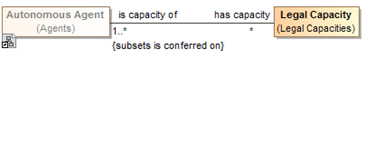A subproperty is a more specific kind of property than some other property, and a super property is a more general kind of property than some other property. For example, “has father” is a more specific property than “has parent”, and “has parent” is a more general property than either “has mother” or “has father”. In the concept modeling interpretation of UML, subsetting a property creates a subproperty when the subsetting property has a different name than the subsetted property. (See section 3.5 Existential Quantification Constraint, for when the name is the same or is omitted.) UML provides a {subsets} constraint that asserts that the values within a subsetting property are also in the set of values within a subsetted property. To stay as close to standard UML as possible, the concept modeling profile interprets a subsetting property having a different name as a subproperty.
The diagram below shows that the property “is capacity of” (owned by the class “Legal Capacity”) is a subset of the global property “is conferred on” (from the property holder “Thing”).
Note
In order to create a subproperty, the subsetting property must have a different name than the property it subsets.
Property 'is conferred on' and subproperty 'is capacity of' having different names.
Related page

